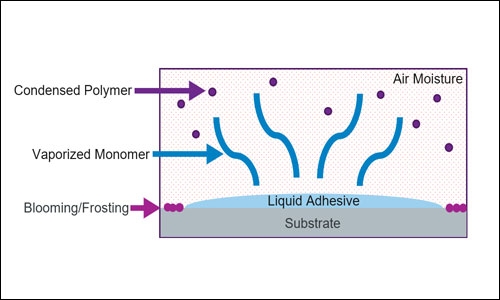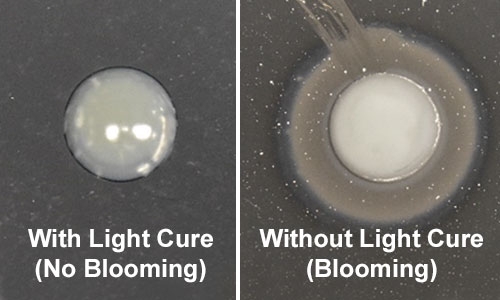The Causes of Blooming in CAs and UVCAs & Solutions to Prevent It From Occurring
Cyanoacrylates (CAs) and UV-curable cyanoacrylates (UVCAs) have gained significant popularity due to their rapid curing capabilities and excellent bonding strength. However, they can encounter some challenges during the application process, including chlorosis.
What is Chlorosis?
Chlorosis (better known as blooming or frosting), is the direct result of the cyanoacrylate monomer volatilizing and interacting with moisture in the air. Once the monomer vaporizes and interacts with air moisture, it becomes a heavier, condensed polymer, and falls back to the surface in that well recognized white, powdery, or frosted appearance. Impurities or contaminants in the formula, such as residual moisture, dust particles, or incompatible additives, can also contribute to chlorosis.
In UV-curable cyanoacrylates, photoinitiators are included in the formulation to provide additional options for curing. While utilizing UV-curing can significantly reduce the chance for blooming by locking the formula in place before the monomer can volatilize, it is important to consider the impact of the photoinitiator in the formula, especially if it is not utilized. The choice of photoinitiator in a formulation can make the material prone to yellowing or degradation under certain conditions.
Combating Chlorosis – How to Reduce or Prevent Blooming
- Expose the material to sufficient UV light during curing. Use appropriate light sources, optimize the exposure time, and avoid a too-fast or too-slow cure.
- Thoroughly evaluate the parts prior to assembly to remove potential sources of contamination or incompatibility. Ensure the substrates are clean and free from contaminants, such as dust, particles, or oils.
- Adequately prepare surfaces. Clean and degrease substrates to promote better adhesion. If a substrate surface is acidic, it will slow the cure and allow more time for volatilization.
- Maintain consistent environmental control. Monitor temperature and humidity conditions during cure to help minimize the migration of adhesive components to surfaces. If these conditions are too low, the cure time may increase and allow for additional time for evaporation. If the temperature and humidity are too high, they may speed up the curing process and increase exotherm.
- Reduce the amount of excess adhesive on components before curing, including potential “squeeze out” or fillets.
- Don't enclose or package a bonded part too soon after assembly, especially if there are any dark or shadowed areas to be cured.
- Avoid using expired material since it tends to cure more slowly.
- Properly store and handle raw materials to maintain the adhesive's integrity.
Chlorosis can be a concern when working with cyanoacrylate and light-curable cyanoacrylate adhesives, impacting their appearance and performance. By understanding the causes of chlorosis and implementing appropriate strategies, such as optimal UV exposure, surface preparation, and bond area optimization, one can minimize the risk and combat this issue effectively. By taking these precautions, users can ensure the successful application with optimal bond strength and aesthetic appeal.
If you're a design engineer seeking an alternative to traditional UVCAs susceptible to chlorosis, you may be interested in our new Hybrid Light Curable (HLC) products. Dymax HLC-M-1000 is a low-to-no blooming light-curable adhesive designed specifically for medical device assembly. Read more about this ground-breaking technology.
Contact Dymax to speak with a technical expert about your specific application.
_________________________________________________________
Enjoying This Content? Let’s Stay Connected.
If you’re finding value in our insights, why not get more of it—delivered right to your inbox? Subscribe to receive the latest technical articles, white papers, product news, and expert tips.


